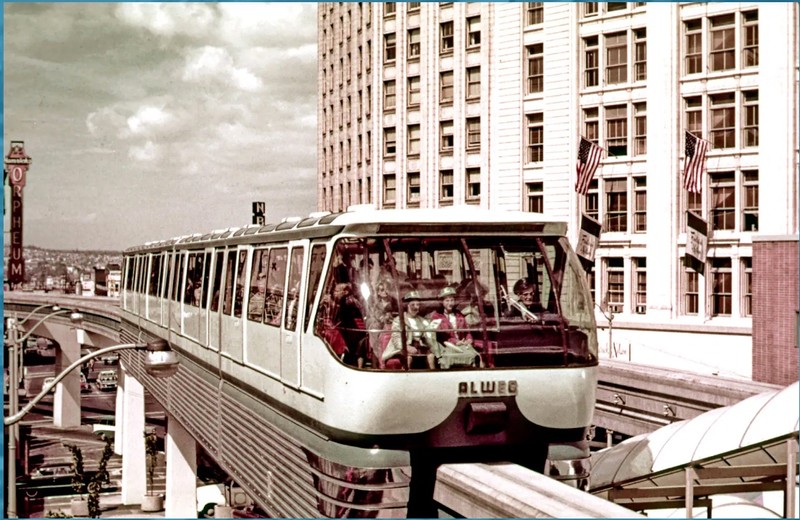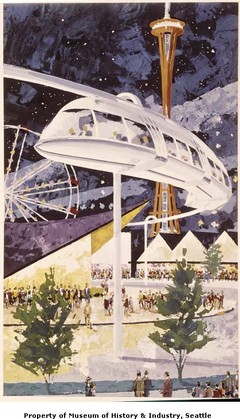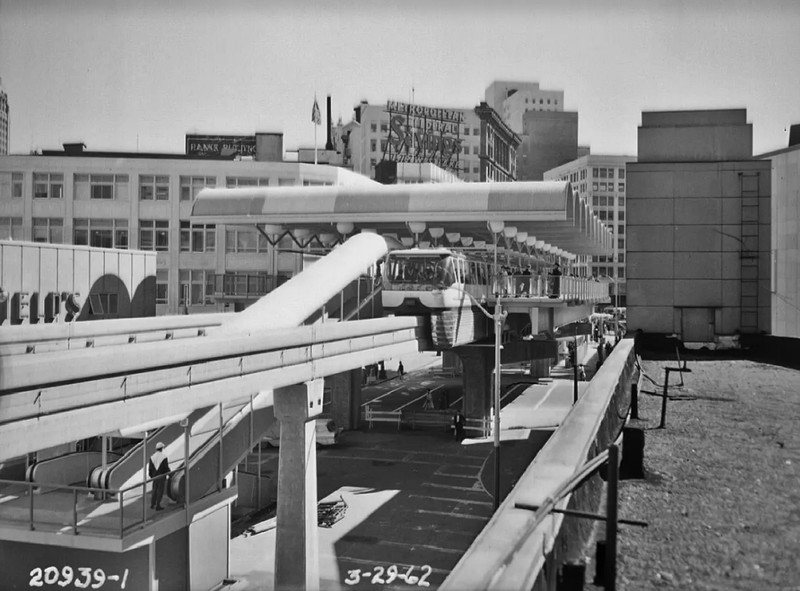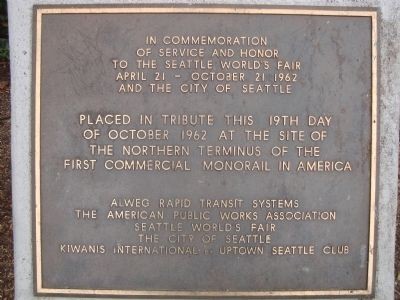The Seattle Monorail and Historical Marker
Introduction
Text-to-speech Audio
This historic station is the location of one of the first commercial monorail transit systems in the United States. The monorail opened in Seattle in 1962, one month before the start of the Century 21 Exposition, a World's Fair event that was held in the city from April through October of that year. During the fair, the monorail transported an estimated 8 million people between the Seattle fairgrounds and downtown. Afterwards, the monorail was turned over to the Century 21 Corporation for no charge. In 1965, the Century 21 Corporation sold the monorail to the City of Seattle, and it has since been used extensively as a public transit system. In October 1962, a historical marker was placed at the original station and also at the northern terminus on the shore of Lake Union. The monorail was designated a Seattle Landmark in 2003.
Images
The Seattle Monorail, a rapid transit system that debuted at the 1962 World's Fair in Seattle, was one of the first commercial monorail systems in the U.S.

Conceptual artwork (1961) for the monorail

In the 1960s, the Seattle Monorail contributed to the city's futuristic aesthetic, which was major theme of the Century 21 Exposition, better known as the 1962 World's Fair

"The First Commercial Monorail in the U.S." Historical Marker commemorates the Seattle monorail as the first of its kind in America, although other U.S. cities and Disney World had already installed monorail systems around this time. This historical marker is located at the northern terminus of the Seattle Monorail on Lake Union.

Backstory and Context
Text-to-speech Audio
The Century 21 Exposition, better known as the Seattle World’s Fair, was a futuristic-themed event held in the city from April through October 1962, with an estimated 10 million visitors. Planning for the fair began several years in advance. In 1957, Seattle voters approved a $7.5 million bond for the development of a public fairgrounds, which was supported by the state legislature. A Century 21 Exposition planning commission was established, and the commission obtained certification from the International Bureau of Expositions so that the event would qualify as an official "World’s Fair."
In August 1958, the U.S. Congress passed legislation (Senate Bill 3680) that established a Federal Commissioner to oversee the U.S. government’s involvement in the fair. This position entailed the appropriation of funds for the construction of new buildings and the issuing of invitations to foreign nations to attend the event. The federal government was especially interested in "demonstrating the nation's scientific prowess to the world," and funding was provided for a NASA-themed United States Science Exhibit at the fair. The exhibit, which was intended to demonstrate the capabilities of U.S. science and technology, later evolved to become the Pacific Science Center.
In 1961, conceptual artwork for a rapid transit system known as the "monorail" was presented to the Century 21 Commission. Although it is similar to a light rail system, a monorail is instead built on a single elevated track, rather than on a ground-based double track. Because of its elevation, a monorail never crosses the path of pedestrians or car traffic. As depicted in an early speculative drawing, the proposed Seattle monorail was initially shown suspended from the track, rather than gliding over it. The design was modified, but the futuristic appearance of the monorail in the earlier drawing was much like the final result. Alweg Rapid Transit Systems, a German engineering company, was hired to build the Seattle monorail in advance of the 1962 World’s Fair.
The general concept was based on a model that been pioneered as early as 1820 in Russia, in which a horse-drawn railcar was suspended on a beam through the city of Moscow. Electric monorails were later built in Europe and at other World Fair events in various U.S. cities, as well as at Disney World around 1960. During the 1962 World's Fair, the Seattle monorail transported an estimated 8 million visitors between the fairgrounds and the city’s downtown amenities. At the conclusion of the fair in October 1962, a historical marker was placed at the monorail's northern terminus on the shore of Lake Union. Today, Seattle’s monorail continues to provide a quick public transit option for locals and for visitors to the city.
Cite This Entry
Hughes, Jenevieve . "The Seattle Monorail and Historical Marker." Clio: Your Guide to History. July 24, 2023. Accessed April 21, 2025. https://theclio.com/entry/171008
Sources
"About the Monorail", Seattle Monorail. Accessed July 24th, 2023. https://www.seattlemonorail.com/about-the-monorail/.
"Century 21 World's Fair," City of Seattle, Municipal Archives. Accessed July 24th, 2023. https://www.seattle.gov/cityarchives/exhibits-and-education/digital-document-libraries/century-21-worlds-fair#.
Cotter, Bill. Seattle's 1962 World's Fair. Images of America. Charleston, SC. Arcadia Publishing, 2010.
"Monorail History", The Monorail Society. Accessed July 24th, 2023. https://www.monorails.org/tMspages/History.html.
"Monorail History", Train History. Accessed July 24th, 2023. http://www.trainhistory.net/railway-history/monorail-history/.
Swackhamer, Barry. "The First Commercial Monorail in the United States", Historical Marker Database. October 7th, 2011. Accessed July 24th, 2023. https://www.hmdb.org/m.asp?m=47939.
"The City of Seattle and the 1962 World’s Fair", City of Seattle. Accessed July 24th, 2023. https://www.seattle.gov/cityarchives/exhibits-and-education/online-exhibits/the-city-and-the-worlds-fair.
Courtesy of Seattle Municipal Archives (Item #73122)
University of Washington Libraries / Museum of Industry and Culture
Courtesy of Seattle Municipal Archives (Item #70912)
Barry Swackhamer, Historical Marker Database

